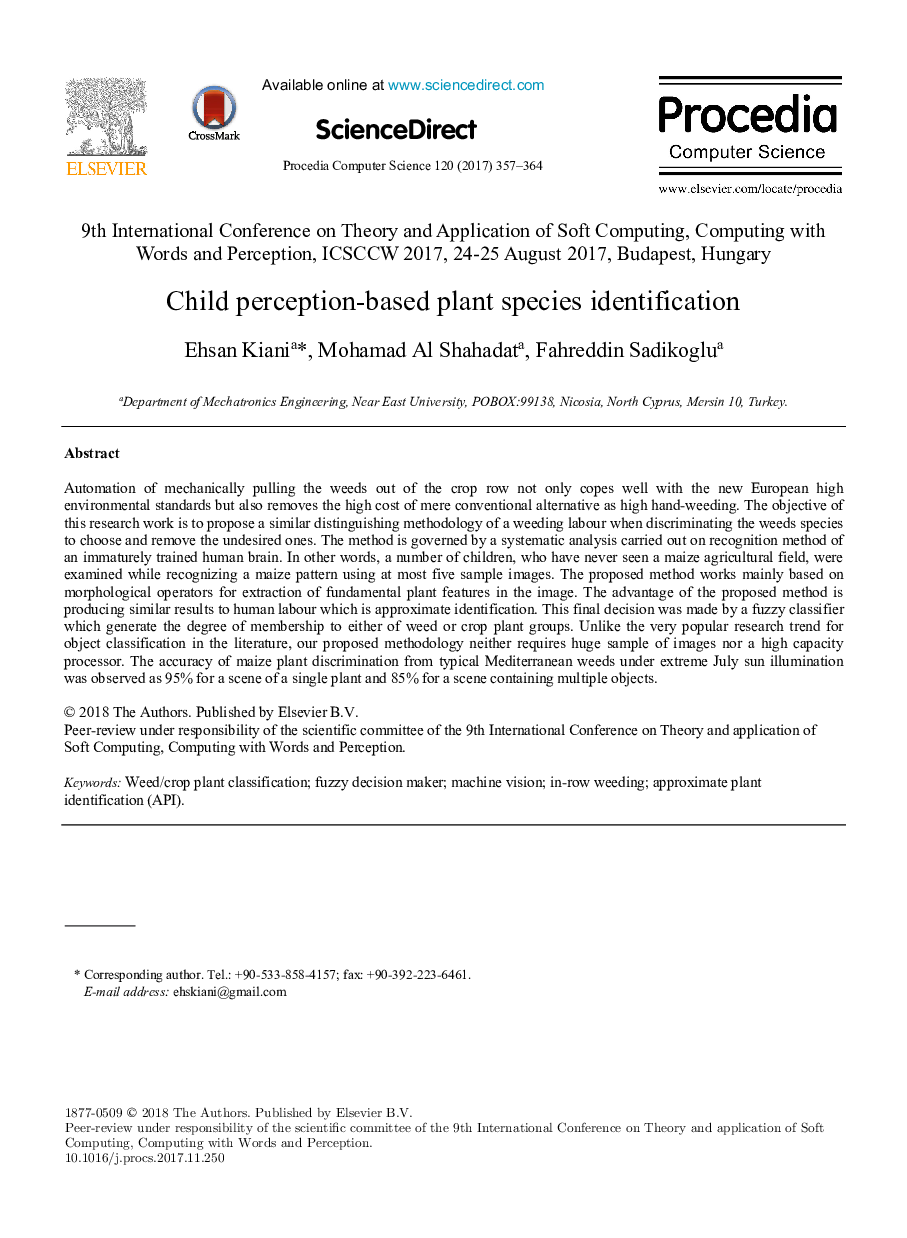| کد مقاله | کد نشریه | سال انتشار | مقاله انگلیسی | نسخه تمام متن |
|---|---|---|---|---|
| 6901756 | 1446495 | 2017 | 8 صفحه PDF | دانلود رایگان |
عنوان انگلیسی مقاله ISI
Child perception-based plant species identification
ترجمه فارسی عنوان
شناسایی گونه های گیاهی مبتنی بر ادراک کودکان
دانلود مقاله + سفارش ترجمه
دانلود مقاله ISI انگلیسی
رایگان برای ایرانیان
کلمات کلیدی
ترجمه چکیده
اتوماسیون مکانیکی کشیدن علف های هرز از ریشه محصول نه تنها با استانداردهای زیست محیطی جدید اروپایی مقابله می کند، بلکه هزینه های بالایی از جایگزین معمولی را نیز به عنوان وجین دست می گیرد. هدف این کار تحقیق این است که روش شناسایی متمایز یک کارگر علفهای هرز را در هنگام تمایز علف های هرز به منظور انتخاب و حذف موارد ناخواسته پیشنهاد دهیم. این روش توسط یک تحلیل سیستماتیک انجام شده بر روی روش شناخت مغز انسان نابالغ آموزش دیده انجام می شود. به عبارت دیگر، تعدادی از کودکان که هرگز میدان کشاورزی ذرت را ندیده اند، در حالی که شناسایی الگوی ذرت با استفاده از حداکثر پنج نمونه نمونه مورد بررسی قرار گرفتند مورد بررسی قرار گرفتند. روش پیشنهادی عمدتا براساس اپراتورهای مورفولوژیکی برای استخراج ویژگی های بنیادی بنیادی در تصویر کار می کند. مزیت روش پیشنهادی نتایج مشابهی را به کار انسانی می دهد که شناسایی تقریبی است. این تصمیم نهایی توسط یک طبقه بندی فازی ساخته شده است که درجه عضویت در هر یک از گروه های علف های هرز یا گیاه را تولید می کند. بر خلاف روند تحقیق بسیار محبوب برای طبقه بندی شی در ادبیات، روش پیشنهادی ما نیازمند نمونه ای بزرگ از تصاویر و پردازنده با ظرفیت بالا نیست. دقت جداسازی گیاه ذرت از علف های هرز معمولی مدیترانه در نور خورشید شدید در تابستان خورشید به میزان 95٪ برای یک صحنه یک گیاه تک و 85٪ برای یک صحنه شامل اشیاء متعدد مشاهده شد.
موضوعات مرتبط
مهندسی و علوم پایه
مهندسی کامپیوتر
علوم کامپیوتر (عمومی)
چکیده انگلیسی
Automation of mechanically pulling the weeds out of the crop row not only copes well with the new European high environmental standards but also removes the high cost of mere conventional alternative as high hand-weeding. The objective of this research work is to propose a similar distinguishing methodology of a weeding labour when discriminating the weeds species to choose and remove the undesired ones. The method is governed by a systematic analysis carried out on recognition method of an immaturely trained human brain. In other words, a number of children, who have never seen a maize agricultural field, were examined while recognizing a maize pattern using at most five sample images. The proposed method works mainly based on morphological operators for extraction of fundamental plant features in the image. The advantage of the proposed method is producing similar results to human labour which is approximate identification. This final decision was made by a fuzzy classifier which generate the degree of membership to either of weed or crop plant groups. Unlike the very popular research trend for object classification in the literature, our proposed methodology neither requires huge sample of images nor a high capacity processor. The accuracy of maize plant discrimination from typical Mediterranean weeds under extreme July sun illumination was observed as 95% for a scene of a single plant and 85% for a scene containing multiple objects.
ناشر
Database: Elsevier - ScienceDirect (ساینس دایرکت)
Journal: Procedia Computer Science - Volume 120, 2017, Pages 357-364
Journal: Procedia Computer Science - Volume 120, 2017, Pages 357-364
نویسندگان
Ehsan Kiani, Mohamad Al Shahadat, Fahreddin Sadikoglu,
